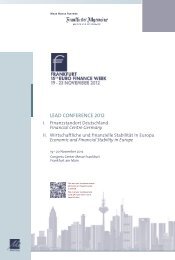The Two European Hydrological Cycles:
The Two European Hydrological Cycles:
The Two European Hydrological Cycles:
You also want an ePaper? Increase the reach of your titles
YUMPU automatically turns print PDFs into web optimized ePapers that Google loves.
<strong>The</strong> <strong>Two</strong> <strong>European</strong> <strong>Hydrological</strong> <strong>Cycles</strong>:<br />
<strong>The</strong> evidence from <strong>European</strong> Research Projects<br />
by:<br />
Millán M. Millán, Dr.Ing.Ind., Ph.D.<br />
Executive Director CEAM, Valencia, Spain<br />
Member of the External Advisory Group in "Global Change and Ecosystems" for the<br />
<strong>European</strong> Commission's 6th Framework Programme.<br />
Synthesis of the Chapter "Climate change and drought: <strong>The</strong> role of critical thresholds and<br />
feedbacks", prepared by the author for the Report: Climate Change Impacts on the Water<br />
Cycle, Resources and Quality, Research-Policy Interface, <strong>European</strong> Commission, 2007:<br />
EUR 22422, Luxembourg: Office for Official Publications of the <strong>European</strong> Communities, 149<br />
pp. (ISBN 92-79-03314-X)<br />
Executive Summary<br />
Probably the most common assumption regarding the hydrological cycle is that the water<br />
resource is universally provided through precipitation by the large weather systems. As this<br />
is not universally true in most parts of the world, the conception that the water resource is<br />
there and all that is required is to manage it properly is perhaps the most widely extended<br />
fallacy regarding the water cycle. In the northern hemisphere (Slide 2), this assumption<br />
holds only in the Atlantic and Pacific Divides north of � 35º North Latitude. Moreover, it can<br />
only be truly asserted for the western side of the continents, i.e., the <strong>European</strong>-Atlantic and<br />
American-Pacific sides of the continents.<br />
For any other Water Divide (Basin) in the world, other processes must be considererd; for<br />
example, the available precipitation in the Central North American Basin, which is lodged<br />
between the Pacific and North Atlantic Divides, is strongly modulated by conditions in the<br />
Gulf of Mexico, i.e., by processes and conditions at the Regional to Subcontinental scales.<br />
In the forested tropical areas (rainforests), after a masive inflow of water vapour at the<br />
beginning of the wet season, the water is basically recirculated between the soil-forest and<br />
the atmosphere, producing a daily afternoon-evening shower. Thus, rainforest means<br />
exactly that; take the forest away and the rain goes along with it, for the area to become a<br />
desert. <strong>The</strong> rainforest is probably the ultimate case where surface properties govern the<br />
precipitation during the wet period.<br />
This document presents our findings about the hydrological cycle in Southern Europe (the<br />
Mediterranean Divide), and the path followed to reach these findings from information<br />
gathered during various <strong>European</strong> Commission projects from 1974 to 1994. <strong>The</strong>se had<br />
alerted of a loss of summer storms around the Western Mediterranean Basin. This issue<br />
was addressed in 1995 by re-analysing the meso-meteorological information obtained in nine<br />
of the EC projects (Slide 3) and disaggregating the precipitation components for one of the<br />
experimental areas used in the projects (Valencia, eastern Spain). <strong>The</strong> analysis shows that<br />
there are three sources of rain in this region, viz: Atlantic Fronts, Summer Storms, and<br />
Mediterranean Cyclogenesis, and that the last two are dominated by land-use-atmosphericoceanic<br />
feedbacks.<br />
Summer storms form (or used to form) in the afternoon, over the mountains surrounding<br />
the basin at 60 to 80(+) km from the sea, in a coastal wind system that develops during<br />
daytime and combines the seabreeze and the up-slope winds, henceforth called the<br />
combined breeze. In this system the seabreeze develops at mid-morning and progresses<br />
inland by incorporating, one after another, the up-slope wind cells formed earlier that day
















